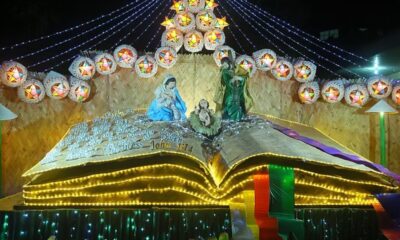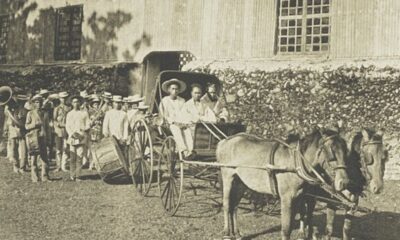NEWS
Historical Churches in Manila

Dig into Manila’s rich historical past. Travel back in time as you walk through the aisles and the courtyards of century old churches. These were vestiges of over 300 years of Spanish colonization that turned the Philippines into the lone Catholic nation in Asia.
The country’s uniqueness from other Asian countries that are either Buddhist or Muslim makes it an ideal pilgrimage place among Christ believers and an alternative destination to European cities where amazing ancient churches draw many tourists.
Malate Church
A church highlighting a fusion of Moorish and Mexican Baroque design in its facade, Malate Church, also known as the Our Lady of Remedios Parish, was founded in 1588. The Augustinians missionaries brought the image of its patron, Our Lady of Remedios from Spain in 1624.
Located along Roxas Boulevard, overlooking Manila Bay, the church was used as headquarters by the British colonizers in 1762. A strong typhoon destroyed the church in 1868, and it was restored between 1894 and 1898. During the Japanese occupation, fire damaged the church. Colombian priests rebuilt it in the 1950s.
Manila Cathedral
The Minor Basilica has undergone several renovations since it was built in 1571 — after it was ravaged by fire, destroyed by earthquakes and damaged by war. It was rebuilt in 1958 adopting a Neo-Romanesque architecture. The church aisle was designed as a Latin cross, wherein you can admire the artistic stained-glass windows designed and created by Filipino artist Galo Ocampo.
Italian artists sculpted the religious images in the cathedral. Its patron image of the Blessed Virgin Mary, the Immaculate Conception was by Vicenzo Assenza, Italy’s national sculptor. Publio Morbiducci, a famous artist during the reign of Mussolini, was responsible for the baptismal font and the angel-shaped holy water fonts, while the mosaic of Our Lady of Sorrows that adorns the wall in the crypt was by artist Marcello Mazzoli.
There is also the statue of Saint Rose of Lima sculpted by Angelo Fattinanzi. The images of Saints Jacob, Andrew, and Anthony the Abbot were by Livia Papini while those of Francis Xavier and Polycarp were by Alcide Tico.
The Latin inscription in one of the arches in the entrance that reads Tibi cordi tuo immaculato concredimus nos ac consecramus (To thy Immaculate Heart, entrust us and concentrate us) greets the churchgoers.
San Agustin Church
The 14th century San Agustin Church is the oldest stone church in the Philippines. It was established in 1571. Construction of its stone structure began in 1586 and was completed in 1607. The design was patterned from some of the magnificent temples in Mexico. Listed as a UNESCO world heritage site, the church is also a national historical landmark. It is also known as the Archdiocesan Shrine of Our Lady of Consolation and Cincture.
Stepping inside, the church will take you to medieval time with its Baroque design — the fully carved choir seats with ivory inlays, the elegant antique chandeliers from France, the trompe-l’oeil murals painted on the ceilings and walls by Italian artists Giovanni Dibella and Cesare Alberoni. Tombs of Spanish conquistador Miguel Lopez de Legaspi, famous painter Juan Luna, Jose Rizal’s friend Trinidad Pardo de Tavera are among the famous and influential names that can be found in the church.
It was also a silent witness to the conclusion of the Spanish-American War in 1891. Spanish governor-general Fermin Jaudenes drafted the terms for the surrender of Manila to the United States of America inside the church. During the Japanese occupation of World War II, it was used as a concentration camp.
Binondo Church
Outside the Spanish enclave across the Pasig River was the area dominated by the Chinese. The oldest Chinatown in the world, you will find the 16th-century Baroque Binondo Church known as the Minor Basilica and National Shrine of Saint Lorenzo Ruiz. Also called the Our Lady of the Most Holy Rosary Parish, it was founded in 1596 by the Dominican priests.
The bell tower is an octagonal pagoda to indicate the presence of the Chinese parishioners. The main altar is a miniature of the facade of the St. Peter’s Basilica in Rome.
National hero Andres Bonifacio and his wife Gregoria de Jesus were married in this church.
Santa Cruz Church
The Parish of Santa Cruz, also called the Our Lady of the Pillar Parish, was the first Catholic church built by the Jesuits in 1619. They brought the statue of Our Lady of the Pillar in 1643. The church is also known as the Archdiocesan Shrine of the Blessed Sacrament.
Earthquakes and war ravaged the original church; it was rebuilt in 1957. Art Deco and Romanesque architecture dominate the interior, while its facade reflects the Spanish Baroque style.
Quiapo Church
Franciscan friars established Quiapo Church in 1588. Now popularly known as the Minor Basilica and National Shrine of Jesus Nazareno (the Black Nazarene), the church was initially dedicated to Saint John the Baptist.
Augustinian missionaries brought the statue of Black Nazarene from Mexico on May 31, 1606. Many believe that the statue is miraculous. January 9 is the Feast of the Black Nazarene; it is a big yearly celebration.
Full construction of the church started in 1686. It was renovated in 1933, following the design drawn by architect Juan Nakpil, the country’s National Artist. To date, only its facade, the dome, the transept and the apse retained its classic Mexican Baroque design.
San Sebastian Church
Visible from a distance because of its towering twin spires, the 19th-century San Sebastian Church stands proudly from its location in Quiapo. Declared a national historical landmark, the church construction started in 1888 and completed in 1891. It was built in steel to make it fire and earthquake resistant. Prefabricated steels were from Belgium and Belgian engineers supervised its construction. Its design is a fusion of Baroque and Neo-Gothic architecture.
The church continues to have its original interiors showing Neo-Gothic lines with its metal doors, walls, ceilings and glass windows. The stained-glass windows were from Germany. On its main altar is the image of Our Lady of Mount Carmel, a gift from the Carmelite Sisters of Mexico City given in 1617.
NEWS
Exploring the Features of Prizmatem: What You Need to Know

Introduction to Prizmatem
Welcome to the world of Prizmatem, where innovation meets functionality. If you’re searching for a tool that can streamline your processes and enhance productivity, you’ve stumbled upon something special. This platform is designed not just to meet user needs but to exceed them in surprising ways.
As technology continues to evolve, staying ahead means embracing tools that are adaptive and efficient. Prizmatem stands out among its competitors by offering unique features tailored for today’s fast-paced environment. Curious about what sets it apart? Let’s dive deeper into the essential aspects of Prizmatem and discover how it can transform your experience!
What makes Prizmatem unique?
Prizmatem stands out in a crowded marketplace with its innovative approach to user engagement. Unlike traditional platforms, it harnesses advanced algorithms to personalize experiences based on individual preferences.
One notable feature is its intuitive interface. Users can navigate effortlessly, making interaction seamless and enjoyable. This ease of use encourages frequent visits and prolonged sessions.
Another aspect that sets Prizmatem apart is its commitment to community-driven content. Users are not just passive consumers; they actively contribute, leading to a rich tapestry of shared knowledge and ideas.
Additionally, Prizmatem integrates cutting-edge security measures. Data protection is paramount here, ensuring that users feel safe while exploring diverse content options.
With regular updates based on user feedback, the platform evolves continuously. This adaptability keeps it relevant and responsive to changing needs within the digital landscape.
Key Features of Prizmatem
Prizmatem stands out with its intuitive user interface. Navigating through its features feels seamless, making it accessible for users of varying tech skills.
One key aspect is its advanced analytics dashboard. Users can track performance metrics in real-time, which helps in making informed decisions quickly.
Customization options are abundant as well. You can tailor the platform to fit specific needs and preferences. This flexibility ensures that every user gets a personalized experience.
Additionally, Prizmatem offers robust integration capabilities. It works smoothly with other tools and platforms you may already be using, enhancing productivity without disruption.
Security is another priority within Prizmatem. With top-notch encryption methods in place, users can trust that their data remains safe from threats or breaches.
Collaboration features also shine brightly here. Teams can work together effortlessly on projects, fostering creativity and communication across different locations.
How does Prizmatem benefit users?
Prizmatem offers a host of benefits tailored to enhance user experience. Its intuitive interface allows users to navigate effortlessly, making it accessible for both beginners and experts.
Efficiency is another hallmark feature. With advanced algorithms, Prizmatem streamlines tasks that typically consume valuable time. Users can focus on what truly matters, whether it’s creative work or project management.
Collaboration thrives within the Prizmatem ecosystem. Team members can connect in real-time, sharing insights and resources seamlessly. This fosters a culture of productivity and innovation.
Additionally, customizability sets Prizmatem apart. Users can adapt features according to their specific needs, ensuring a personalized experience every time.
Moreover, robust customer support adds an extra layer of confidence for users embarking on their journey with Prizmatem. This dedication ensures that help is always just a click away when challenges arise.
Case studies: Success stories using Prizmatem
Prizmatem has already made waves in various industries, showcasing its versatility and effectiveness. One notable case study involves a mid-sized marketing agency that faced challenges with data analysis and reporting. After integrating Prizmatem into their workflow, they reported a 40% increase in efficiency when compiling client reports.
Another success story comes from an e-commerce platform struggling with inventory management. By utilizing Prizmatem’s analytics tools, they optimized stock levels and reduced waste by nearly 30%. This directly contributed to higher profit margins.
In the healthcare sector, a clinic adopted Prizmatem for patient data tracking. The result? Improved patient care through timely insights and streamlined communication among staff members.
These examples highlight how organizations across different fields harness the power of Prizatm to solve real-world problems effectively. Each success story reflects the adaptability of this innovative tool in achieving tangible results.
Tips for maximizing the use of Prizmatem
To get the most out of Prizmatem, start by familiarizing yourself with all its features. Take time to explore each tool and function. This will help you understand how they can best serve your needs.
Utilize the platform’s analytics tools regularly. They provide valuable insights into performance. By tracking your usage patterns, you can identify areas for improvement.
Engage with community forums or user groups dedicated to Prizmatem. Sharing experiences and tips with fellow users often leads to discovering new strategies that enhance functionality.
Don’t hesitate to customize settings according to your preferences. Personalization improves efficiency and ensures a smoother experience tailored specifically for you.
Keep an eye on updates from the developers; they frequently roll out enhancements based on user feedback. Staying informed about these changes helps you adapt quickly and leverage new capabilities effectively.
Future developments and updates for Prizmatem
Prizmatem is poised for exciting advancements in the coming months. The development team is actively gathering user feedback to refine its features further. This commitment to community input ensures that updates align with user needs and expectations.
New integrations are on the horizon, expanding Prizmatem’s compatibility with popular tools and platforms. Users can look forward to seamless connections that enhance workflow efficiency.
Additionally, enhanced analytics capabilities are being developed. These improvements will provide users with deeper insights into their performance metrics, allowing for data-driven decision-making.
The roadmap also includes plans for mobile accessibility. A dedicated app could make Prizmatem even more convenient for users on the go.
Stay tuned as these innovations roll out, transforming how users interact with Prizmatem and maximizing its potential in various applications.
Conclusion
Prizmatem stands out as a powerful tool that offers unique advantages for its users. Its innovative features cater to diverse needs, making it an asset in various domains. As we’ve explored, the key benefits of Prizmatem can lead to meaningful improvements in productivity and efficiency.
Success stories highlight how businesses have transformed their operations with this platform. Users are encouraged to leverage these insights while also customizing their approach based on specific goals. By adopting best practices, one can unlock even more potential from what Prizmatem has to offer.
Looking ahead, continuous updates promise enhanced functionalities and better user experiences. Staying informed about these developments will ensure that you maximize your engagement with Prizmatem effectively.
Embracing tools like Prizmatem could very well be the step towards achieving greater success in today’s fast-paced environment. Whether you’re looking for innovation or efficiency, exploring this platform further may just be the right move for you.
NEWS
Exploring Lexoworpenz: Key Features and Benefits Explained

Introduction to Lexoworpenz
Welcome to the world of Lexoworpenz, where innovation meets practicality. If you’ve been searching for a solution that simplifies your everyday tasks while enhancing productivity, you’re in the right place. Lexoworpenz stands out from the crowd with its unique offerings designed to cater to diverse needs. Whether you’re a business owner, a student, or someone looking for efficient tools in daily life, this platform has something special for everyone. Let’s dive in and explore what makes Lexoworpenz a game-changer!
Understanding the Unique Features of Lexoworpenz
Lexoworpenz stands out with its intuitive interface, designed for seamless user experience. Users can navigate effortlessly through various functions, making it accessible to both beginners and experts.
One of the most compelling features is its customizable dashboard. This allows users to tailor their workspace according to individual preferences and needs.
Additionally, Lexoworpenz integrates advanced analytics tools that offer real-time insights. These capabilities empower users to make informed decisions quickly.
Another highlight is the robust security framework protecting sensitive information. With encryption protocols in place, data safety remains a top priority.
Collaboration tools within Lexoworpenz foster teamwork by allowing multiple users to work on projects simultaneously. This feature enhances productivity and streamlines workflows effectively.
Regular updates ensure that Lexoworpenz evolves over time, incorporating user feedback into new functionalities continuously.
Benefits of Using Lexoworpenz
Lexoworpenz offers a range of benefits that make it an attractive option for users. One standout advantage is its user-friendly interface, which allows even beginners to navigate with ease. This accessibility encourages more individuals to engage with the platform.
Another major benefit is its robust functionality. Lexoworpenz provides tools and features tailored to enhance productivity and streamline workflows. Users can accomplish tasks efficiently without feeling overwhelmed.
Moreover, the integration capabilities set Lexoworpenz apart from competitors. It works smoothly with various software systems, offering flexibility in managing different projects or tasks seamlessly.
Additionally, regular updates keep the program fresh and relevant. Users can expect new features periodically that address common pain points or introduce innovative solutions.
With strong community support, finding assistance or resources becomes effortless. Engaging forums help foster connections among users sharing experiences and insights about using Lexoworpenz effectively.
How to Get Started with Lexoworpenz
Getting started with Lexoworpenz is a straightforward process. First, visit the official website to create an account. This step only takes a few minutes.
Once registered, explore the user-friendly interface. Familiarize yourself with various tools and features through guided tutorials. These resources are designed to help you hit the ground running.
Next, consider customizing your settings for a more personalized experience. Adjust notifications and preferences based on your needs.
Don’t hesitate to engage with the community forums as well. Connecting with fellow users can provide valuable insights and tips that enhance your understanding of Lexoworpenz.
Take advantage of any available trial periods or demo options. Hands-on experience will give you confidence in using this innovative tool effectively from day one.
Success Stories from Users of Lexoworpenz
Users of Lexoworpenz have shared inspiring stories that highlight its transformative power. One user, a small business owner, reported a significant boost in productivity after integrating Lexoworpenz into their daily operations. Tasks that used to take hours were completed in mere minutes.
Another user highlighted the ease of collaboration with team members. With Lexoworpenz, they could seamlessly share ideas and feedback without the usual back-and-forth emails. This streamlined communication helped them meet deadlines faster than ever before.
A nonprofit organization also experienced remarkable results. By utilizing Lexoworpenz for their outreach programs, they reached a broader audience and increased donations by over 30%. The platform’s tools enabled them to engage supporters more effectively.
These success stories showcase how diverse users leverage Lexoworpenz to achieve their unique goals. Each tale reflects not just improvement but genuine growth across various industries and sectors.
Comparison with Other Similar Programs
When evaluating Lexoworpenz, it’s valuable to compare it with other similar programs in the market. Many platforms offer features that seem comparable at first glance, but a deeper dive reveals distinct differences.
Unlike some alternatives that focus solely on basic functionalities, Lexoworpenz integrates advanced analytics and user-friendly interfaces. This makes navigation intuitive for both beginners and seasoned users alike.
Some competitors may excel in specific areas like pricing or customer support. However, they often fall short regarding versatility and range of applications. Lexoworpenz stands out by providing a comprehensive suite tailored for diverse needs.
Furthermore, while many programs require extensive training for effective use, Lexoworpenz is designed for quick onboarding. Users can start leveraging its capabilities right away without steep learning curves.
In essence, choosing the right program hinges on understanding these nuances and how they align with your unique requirements.
Tips for Maximizing the Use of Lexoworpenz
To maximize your experience with Lexoworpenz, start by exploring its user interface thoroughly. Familiarize yourself with all features and tools available.
Set specific goals for what you want to achieve using the platform. This clarity will guide your actions and keep you focused.
Utilize community forums or groups related to Lexoworpenz. Engaging with fellow users can provide valuable tips and insights that enhance your understanding of the program.
Experiment with different settings and customizations within Lexoworpenz. Personalizing it to fit your workflow can significantly boost productivity.
Regularly check for updates or new features introduced in Lexoworpenz. Staying informed ensures you’re leveraging the latest advancements for optimal results.
Take advantage of any tutorials or resources provided by the developers. These materials often contain hidden gems that can elevate your usage further.
Conclusion
Lexoworpenz stands out as a remarkable tool for those looking to enhance their productivity and streamline processes. With its unique features tailored to meet modern demands, users can unlock numerous benefits that make tasks simpler and more efficient.
Whether you’re just getting started or are already on your way with Lexoworpenz, the success stories from current users highlight its effectiveness in various scenarios. The comparisons with similar programs show that Lexoworpenz offers distinct advantages worth considering.
Maximizing your experience with this platform is crucial for reaping all of its rewards. Implementing tips shared by seasoned users can further elevate how you utilize the program.
Embracing Lexoworpenz could lead you toward achieving greater efficiency and satisfaction in your daily activities. Explore it today, and see how it transforms your workflow for the better!
NEWS
The Art of Font Design: How Fontlu Makes It Accessible for Everyone

Introduction to font design and its importance
Font design is often an overlooked art form, yet it holds incredible power. The right font can evoke emotions, enhance readability, and even transform a brand’s identity. In today’s digital world, having access to creative and unique typefaces is essential for designers of all levels. Yet many find themselves intimidated by the complexities of font creation or simply unable to afford custom designs.
Enter Fontlu—a groundbreaking platform that aims to break down barriers in font design. With its user-friendly tools and inclusive approach, Fontlu invites everyone into the world of typography, empowering both novices and seasoned designers alike to unleash their creativity. Whether you’re crafting a logo or designing marketing materials, Fontlu makes it easier than ever to bring your vision to life through stunning fonts. Let’s explore how this innovative platform is reshaping the landscape of font design for all creators!
The birth of Fontlu and its mission to make font design accessible
Fontlu emerged from a simple yet powerful idea: to democratize font design. The founders recognized that creating unique fonts shouldn’t be confined to experts alone. Many talented individuals lacked the tools or knowledge to bring their typographic visions to life.
Driven by this vision, Fontlu was established as an intuitive platform where creativity knows no bounds. It aims to empower everyone—whether you’re a budding designer or an industry veteran—to explore and experiment with typography.
The mission is clear: make font creation accessible for all. By breaking down complex processes into user-friendly features, Fontlu invites anyone interested in design to participate in this artistic journey. This commitment ensures that diverse voices can contribute their styles and stories through custom fonts.
Features and tools available on Fontlu’s platform
Fontlu offers a diverse array of features designed to enhance the font design experience. Users can explore an extensive library of typefaces, ranging from classic styles to modern creations.
The intuitive interface makes it easy for anyone to navigate through options. With drag-and-drop functionality, users can experiment with different designs effortlessly.
One standout feature is the customization tool, allowing designers to tweak letter shapes and spacing. This flexibility lets creativity flow without constraints.
Collaboration is seamless on Fontlu as well. Teams can share projects and gather feedback in real-time, making it easier to refine ideas together.
Additionally, Fontlu provides tutorials and guides tailored for different skill levels. Whether you’re just starting or have years of expertise, there’s something valuable waiting for you on this platform.
How Fontlu caters to both beginners and professionals
Fontlu understands that font design is a journey for everyone, whether you’re just starting out or have years of experience. Its user-friendly interface welcomes beginners with open arms. Simple tutorials and templates help novices create stunning designs without feeling overwhelmed.
For experienced designers, Fontlu offers advanced features like customizable glyphs and extensive style libraries. Professionals can dive deeper into their creativity with tools that allow precise modifications to every letterform.
Collaboration is another key aspect of Fontlu’s platform. Beginners can learn from seasoned designers through shared projects while professionals receive fresh perspectives on their work.
The blend of simplicity and sophistication makes Fontlu a versatile choice for all skill levels. Everyone has the opportunity to explore new ideas in an inspiring environment tailored specifically for their needs.
Success stories of users who have used Fontlu for their design projects
Fontlu has transformed the way designers approach typography. Many users have shared their remarkable experiences using this innovative platform.
Take Anna, a freelance graphic designer who struggled to find the right font for her clients’ branding projects. After discovering Fontlu, she quickly crafted custom fonts tailored to each brand’s personality. Her creativity flourished with newfound inspiration.
Then there’s Mark, an aspiring designer who previously felt intimidated by traditional design tools. Fontlu’s user-friendly interface allowed him to experiment freely without feeling overwhelmed. He designed his first complete typeface and received rave reviews from peers.
These stories are just glimpses of how Fontlu empowers people at every skill level. It bridges gaps in knowledge and opens doors to creative possibilities that many didn’t think were achievable before joining the community. The excitement is palpable as more designers share their journeys with Fontlu daily.
Future plans for Fontlu and the world of font design
Fontlu is constantly evolving. The team behind the platform has ambitious plans to expand its offerings, aiming to introduce even more intuitive design tools.
They envision features that integrate AI technology, enabling users to generate custom fonts based on their specific needs. This will empower designers to experiment like never before.
Additionally, Fontlu aims to foster a community where creators can share their projects and collaborate on designs seamlessly. Workshops and tutorials are in the works as well, ensuring everyone—from beginners to seasoned professionals—can enhance their skills.
With an eye towards inclusivity, future updates will focus on making font creation accessible across various languages and cultures. This commitment aims not only at diversity but also enriches the global design landscape with unique perspectives.
The world of font design is poised for transformation with Fontlu leading the charge into exciting new territories.
Conclusion: The impact of Fontlu on the design industry and its accessibility for all
Fontlu is revolutionizing the way we approach font design. Its user-friendly platform empowers both beginners and seasoned designers, breaking down barriers in an industry that can often feel exclusive. The array of tools available allows users to experiment and create with confidence, while success stories showcase the transformative potential of Fontlu’s offerings.
As more people tap into their creativity through this innovative platform, the impact on the design industry becomes clear. Accessibility meets artistry, enabling a wider range of expression than ever before. Fontlu is not just making font design easier; it’s fostering a community where everyone has a voice and every idea can take shape.
With exciting plans for future developments, it’s evident that Fontlu will continue to play a significant role in shaping how fonts are created and utilized across various mediums. As access to quality design tools improves, so does the overall standard within the industry—ultimately benefiting creators everywhere. The journey towards inclusive design continues, with Fontlu leading the charge toward a future where creativity knows no bounds.
-

 TOPIC4 months ago
TOPIC4 months agoSymbols of Hope: The 15th Belenismo sa Tarlac
-

 TOPIC4 months ago
TOPIC4 months ago“The Journey Beyond Fashion” – Ditta Sandico
-

 TOPIC4 months ago
TOPIC4 months ago“Recuerdos de Filipinas – Felix Laureano”
-

 TOPIC4 months ago
TOPIC4 months agoRIZAL at 160: a Filipino Feat in Britain
-

 TOPIC4 months ago
TOPIC4 months agoBoats with Two Strings
-

 TOPIC4 months ago
TOPIC4 months ago5 Must-Have Products From Adarna House to Nurture Your Roots
-

 TOPIC4 months ago
TOPIC4 months agoA Taste of Art, A Brush of Flavor: The Culinary and Creative Genius of Claude Tayag
-

 TOPIC4 months ago
TOPIC4 months agoFilipino, alternative language course at Moscow State University
